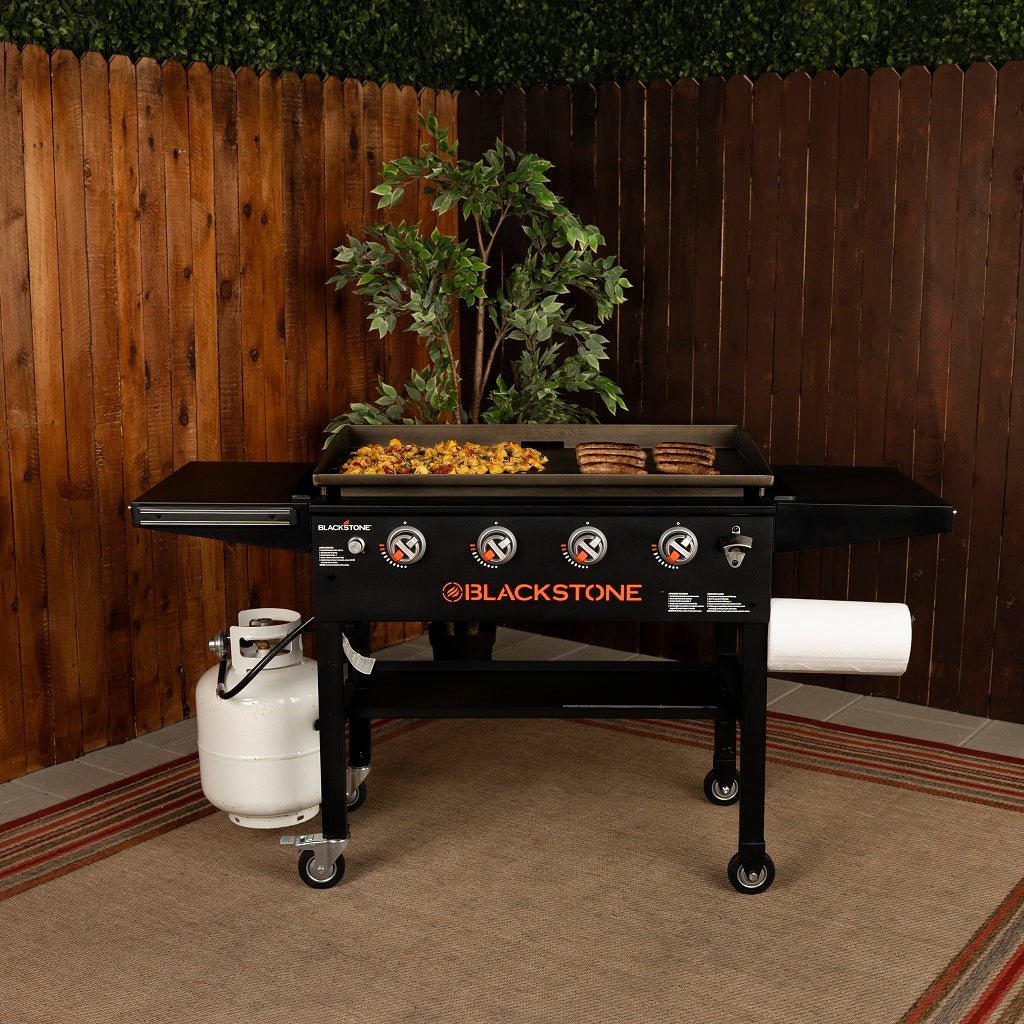
Griddles vs Grill
We get all kinds of questions about cooking here at Blackstone. One of the most common is whether we call our Blackstone a griddle or a grill? Although the answer comes down to personal preference, let’s look at the differences between a griddle and let you come to your own conclusion on what you should call it.
What is the difference between an outdoor griddle and a grill?
An outdoor grill is a cooker that has a stand-alone heat source for cooking. Grills are most commonly powered by gas or charcoal and can reach temperatures of 600F or more.
When you cook on a grill, food is placed on grill grates above the heat source, which is typically an open flame. The grill’s grates are made of metal. They are a series of parallel slats set a half an inch apart about or so that aren’t quite the thickness of a pencil.
Outdoor griddles, on the other hand, are powered like a grill. The biggest difference between an outdoor grill and a griddle is the cooking surface. Unlike a grill’s grate which leaves food often exposed to direct flame, a griddle is a smooth, flat surface that food is cooked on, like a giant pan or skillet.
Does food cook differently on an outdoor grill than on an outdoor griddle?
There are both subtle and significant differences in how food cooks on a grill versus how it cooks on a griddle.
The first thing that happens when food is placed on the grates of a hot grill is you hear it sizzle. That sound is from conduction or heat transfer between objects by direct contact.
The open space between the grates also plays a role in how food cooks. It allows food to cook via both convection and radiation. Convection and radiant cooking happen from the heat of the grill circling around the food and causing it to cook.
Radiant cooking also has to do with the food’s proximity to the heat source.
To better explain radiant cooking, think when you’re chilly and go to warm near a wood stove or fireplace. If you’re really cold, you can sit closer to the fire and warm up quicker but over time the heat will become unbearable, forcing you to move away so you don’t get burned. That’s an example of radiant heat.
The same is true for cooking.
If you’ve ever made a S’more over a campfire, you know there’s a sweet spot for toasting the marshmallows where they get perfect and melty.
But radiant cooking is hard to manage. Think about when you get the marshmallows too close to the heat. They often burn or burst into flames. Although radiant cooking works for campfire S’mores, the method is challenging and impractical.
Compared to open fire cooking, griddles have a special relationship with heat.
Since the entire cooking surface on a griddle is heated, food cooks differently than when cooked over an open fire. It greatly benefits from conduction.
Conduction isn’t just what makes food sizzle when it’s set down to cook on a hot surface; it’s part of what makes food delicious.
When you set food down on a grill, the majority of conduction occurs where it comes into surface contact with the grill’s grates. But when you set food down on a griddle, the entire surface of the food comes in contact with the heat, which can make it significantly tastier than cooked on a grill alone.
Let’s use the most basic cheese sandwich as an example. You can stick a slice of cheese between two slices of bread and it’s edible.
But put that same bread and cheese on a griddle with a little butter and everything changes. The bread becomes golden and browned. The cheese melts, and the exterior of the sandwich develops a slightly crisp texture while remaining pillowy and soft on the interior.
Is there a benefit to griddle cooking versus grilling?
Absolutely.
Anyone who has ever owned a stove or cooked in a pan is qualified to cook on a griddle.
Griddle cooking is not just the man’s domain or a place for women to cook. If you’ve ever used a stove, there’s not much of a learning curve for cooking on a griddle. Because of all that available cooking space, it may even be easier than cooking in your kitchen.
True grilling on grill grates over an open flame is intimidating to many people. Food can stick, fall through the grates, and burn quickly if you’re not paying attention. But a griddle is much more forgiving. Temperatures can be controlled by either turning down the heat or moving foods to a cooler area on the griddle. Food won’t fall into the fire because there are no gaps for it to fall through. A properly seasoned griddle surface allows food to slide around without sticking under most circumstances.
I wouldn’t say you should get rid of your grill just yet, but it should be on notice that your griddle has some amazing things going for it.
So the next time you think about cooking hash browns outside consider how much easier it would be on a griddle surface than chasing potato bits between grill grates.

